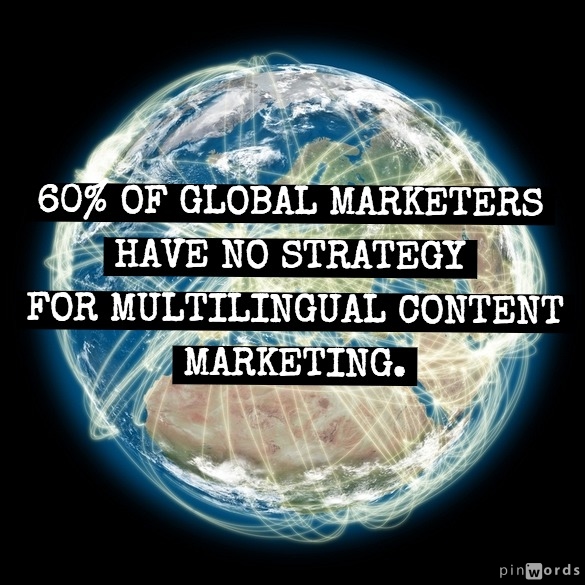
Global marketers are on the hook to increase demand for their products around the world.
If you’re a global content marketer, you stoke those fires with a content portfolio—blogs, reports, infographics, collateral, and more—that speaks to your audience’s interests, differentiates your company from competitors, and nurtures a carefully constructed customer experience.
It’s already a huge challenge to produce and deliver all the content your company requires in one language. But translating these assets into all the languages of your target markets can be paralyzing. If that’s your experience, you’re not alone.
60% of global marketers have no strategy for multilingual content marketing.
We surveyed 500+ global marketers in 2013, and 60% of them had no strategy for multilingual content marketing. Like many other marketers I’ve talked to, they delay thinking about translation until after their content is produced, which, at best, makes the process even more painful, tedious, and expensive. At worst, it costs their companies significant dollars in lost opportunities.
The Numbers Say It All: Don’t Skimp on Translation
It takes 12 languages to communicate with 80% of the global online audience (Source: CSA). With so much content being generated and shared (27,000,000 pieces of content a day!) and given the massive market opportunities across the globe, it’s more important than ever to have a fool-proof game plan for delivering content to global audiences at scale.
Simply put, localization can no longer be treated as an afterthought. There’s just too much at stake. How much? Consider these statistics:
- By 2025, the number of global consumers in emerging economies will reach 4.2 billion, and annual consumption in emerging global markets will increase to $30 trillion.
- The global revenue opportunity available to companies using online communications rose to $44.6 trillion in 2012, and only a third of that amount is available to companies that communicate only in their native English language.
- Fortune 500 companies that deliver content in native languages to keep up with or gain an edge over their competitors are twice as likely to see increased profits and 1.25 times more likely to generate increased earnings per share.
“Localization can no longer be treated as an afterthought.”
Of course, if it were easy to deliver multilingual content, everyone would be doing it. Without well-thought-out processes, and the infrastructure to support it, it is complex and there are a lot of moving parts. But the above figures demonstrate that it behooves marketers to crack the code on global content marketing, and benefit from the many compelling reasons to take the border-hopping plunge:
Multilingual Content Helps Close Deals and Protect Your Brand
Almost 60% of global consumers say getting info in their own language is more important than price when making a purchase decision (source: CSA). Without localized content, your marketing and sales organizations will sacrifice potential revenue and lose share to competitors who create multilingual content effectively. With localized content, you’ll drive more web visitors, nurture more leads, and close more deals.
Planning Ahead Will Help Speed Delivery and Avoid Missed Opportunities
A typical approach to localization of content marketing that I see is a staggered “roll-out” of translations over time. The longer it takes to deliver your content to your target markets, the more competing messages your sales force will have to position against, and the longer it will take to capture market share and revenue in those markets. That’s what happens, though, when you translate your content after the fact. Wouldn’t you rather be the hero who gets your company’s content to all key markets at the same time?
The Bottom Line: Translated Content Is King…of the World!
Thinking about translation as you map out your global content marketing strategy, not after, will ensure you produce assets that will have greatest world-wide impact, reduce the time and money spent on translation projects by creating global economies of scale, deliver consistent branding and messaging while addressing local needs, and, most importantly, capture global market share and revenue faster.
For more information on how to get global content marketing right, watch this space for future posts. In the meantime, download the ebook “Content Operations on a Global Scale: A 2014 Guide for the Marketing Globerati.“
